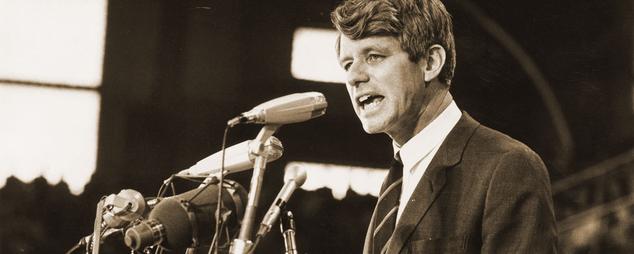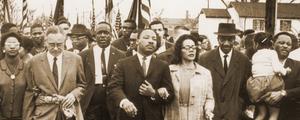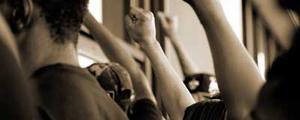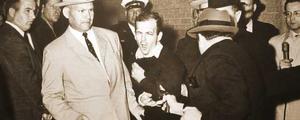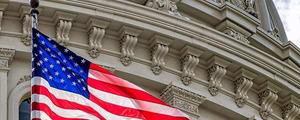Robert Kennedy came into the national spotlight in 1961 when he served as U.S. attorney general in his brother John F. Kennedy's administration. He remained a prominent national figure after his election as a U.S. senator from New York in 1964. He ran for the Democratic presidential nomination in 1968 until he was struck down by an assassin's bullet on June 5, 1968; he died the next day.
Across these years, Gallup found most Americans holding a positive view of Kennedy, although his favorable rating ebbed as the presidential campaign progressed.
| May 1963 | May 1964 | August 1966 | August 1967 | May 1968 | |||||||||||||||||||||||||||||||||||||||||||||||||||||||||||||||||||||||||||||||||||||||||||||||
|---|---|---|---|---|---|---|---|---|---|---|---|---|---|---|---|---|---|---|---|---|---|---|---|---|---|---|---|---|---|---|---|---|---|---|---|---|---|---|---|---|---|---|---|---|---|---|---|---|---|---|---|---|---|---|---|---|---|---|---|---|---|---|---|---|---|---|---|---|---|---|---|---|---|---|---|---|---|---|---|---|---|---|---|---|---|---|---|---|---|---|---|---|---|---|---|---|---|---|---|
| % | % | % | % | % | |||||||||||||||||||||||||||||||||||||||||||||||||||||||||||||||||||||||||||||||||||||||||||||||
| Highly favorable (+5, +4) | 29 | 40 | 41 | 33 | 24 | ||||||||||||||||||||||||||||||||||||||||||||||||||||||||||||||||||||||||||||||||||||||||||||||
| Somewhat favorable (+3, +2, +1) | 43 | 33 | 33 | 38 | 37 | ||||||||||||||||||||||||||||||||||||||||||||||||||||||||||||||||||||||||||||||||||||||||||||||
| Somewhat unfavorable (-3, -2, -1) | 11 | 10 | 12 | 13 | 20 | ||||||||||||||||||||||||||||||||||||||||||||||||||||||||||||||||||||||||||||||||||||||||||||||
| Highly unfavorable (-5, -4) | 10 | 9 | 11 | 13 | 19 | ||||||||||||||||||||||||||||||||||||||||||||||||||||||||||||||||||||||||||||||||||||||||||||||
| No opinion | 8 | 8 | 3 | 2 | 0 | ||||||||||||||||||||||||||||||||||||||||||||||||||||||||||||||||||||||||||||||||||||||||||||||
| Total favorable | 72 | 73 | 74 | 71 | 61 | ||||||||||||||||||||||||||||||||||||||||||||||||||||||||||||||||||||||||||||||||||||||||||||||
| Total unfavorable | 21 | 19 | 23 | 26 | 39 | ||||||||||||||||||||||||||||||||||||||||||||||||||||||||||||||||||||||||||||||||||||||||||||||
| Gallup | |||||||||||||||||||||||||||||||||||||||||||||||||||||||||||||||||||||||||||||||||||||||||||||||||||
Most of Gallup's polling on Kennedy centered on his presidential run, starting well before he formally announced his candidacy. Here are some highlights of that polling, including links to Gallup's original news coverage.
A Promising Start
Kennedy's chances of winning the 1968 Democratic nomination for president looked promising two years earlier, in March 1966, when a Gallup poll of U.S. adults found him beating Republican Richard Nixon by 54% to 41% in a hypothetical general election ballot. The same poll found Lyndon Johnson's vice president, Hubert Humphrey, faring far less well, running neck-and-neck with Nixon: 47% for Humphrey vs. 45% for Nixon.
March 11, 1966: "Trial Heat: Robert Kennedy, 54%, Richard Nixon 41%"
In August 1966, George Gallup wrote about Kennedy's "meteoric rise" in popularity, citing an increase in the percentage of Democrats choosing Kennedy over Johnson for the party's nomination. Whereas Kennedy had trailed Johnson by 27% to 52% in February 1966, in August the two were tied, with Kennedy winning 40% of the Democratic vote to Johnson's 38%.
About this time, Gallup asked Americans to say, in their own words, what they thought were Kennedy's good and bad points. Five good points were named by at least 5% of Americans -- among them that he worked hard (9%), was honest and sincere (8%), was intelligent (7%), was a Kennedy (7%) and was a pleasant, likable person (5%). Three responses rose to the level of 5% on the negative list: that he was power hungry (7%), that he was riding on the Kennedy name (6%), and that he had a poor personality or temper (5%).
By January 1967, Kennedy was the front-runner for the Democratic nomination, beating Johnson by 43% to 34%, with other contenders picking up less support.
Jan. 29, 1967: "RFK's Political Star Continues to Rise"
Democratic Competition Revs Up
It was still early in the campaign, however, and Gallup polling soon showed Johnson pulling ahead of Kennedy in voter preferences. Also, the percentage of Americans with a highly favorable opinion of Kennedy fell from 41% in August 1966 to 33% by August 1967.
May 10, 1967: "Kennedy Support Declining"
Throughout this period, it was assumed Johnson would run for a final term. However, on March 31, 1968, the president announced he would neither seek nor accept his party's nomination. Thereafter, the contest for the Democratic nomination was largely a race among Kennedy, Humphrey and Eugene McCarthy. And according to Gallup, this was not a field that excited the public. In fact, none of the six leading contenders for president from either party received highly favorable ratings from more than 30% of Americans, according to Gallup's 10-point Stapel Scalometer. Nixon's highly favorable rating was the best, at 28%, while Kennedy's 24% put him third behind Humphrey, at 26%.
As Gallup noted at the time, "No one today reaches the high favor found for Lyndon Johnson in 1964, Richard Nixon and Sen. John Kennedy in 1960, President Eisenhower and Adlai Stevenson in 1956 and 1952."
May 19, 1968: "Lack of Enthusiasm Found for '68 Candidates"
As of mid-May, both Nixon and his Republican challenger, Nelson Rockefeller, were preferred over all three Democratic candidates in Gallup's fall election trial heats, with Kennedy performing the worst of the three.
May 12, 1968: "Nixon, Rockefeller Lead All 3 Democratic Candidates"
Momentum Near the End
In Gallup's final poll on Kennedy -- which preceded his victory in the California Democratic primary two days before his death -- Kennedy trailed Humphrey, 36% to 48% (in a two-way race), in Democrats' preferences for their party's nomination. He was tied with Nixon in a trial-heat ballot of U.S. voters for the November election.
Read more from the Gallup Vault.
